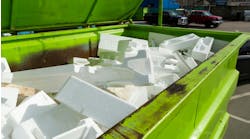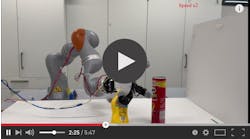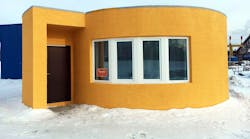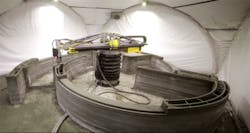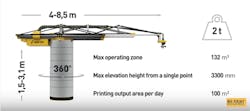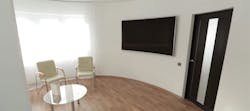A lot of investors got hit hard when the 3D printing companies they bought into didn't produce results as rapidly as they did prototypes. Reality did not meet the wild expectations of hype-mongers who promised a 3D printer in every home to manifest replacement parts for the washer or a new action figure for your kid. That's not a knock on the technology; it's more anecdotal evidence of our collective foolishness when it comes to shiny new objects.
No, 3D printers won't be in every home for quite some time, if ever. But what if someday they made every home?
This is the concept San Francisco-based startup Apis Cor sought to validate recently in the frigid outskirts of Moscow with its innovative mobile construction 3D printer and automatic mix and supply unit. Instead of PLA, the printer here lays down concrete. The extrusion head moves like a crane, rotating 360 deg while it dispenses the mix in max area of 132 m².
Photo: Apis Cor
The unforgiving Muscovite winters have beaten back both Napoleon and Hitler's war machines, but the freezing temperatures could not impede this current technological progress. Under the warmer confines of a tent at an aerated concrete facility, the 3D printer successfully fabricated a 400-ft² house in 24 hours. The company says the equipment works in -31°F, but the concrete mix isn’t feasible under 41°F. A geopolymer is being developed to facilitate year-round printing.
Unlike the plastic 3D-printed doodads you picked up at your last trade show, this house was built to last, with a lifespan of more than 50 years. The Cold War didn’t even make it that long.
Most of the construction was automated, with workers coming in to install insulation and ceilings, and finish the exterior.
Photo: Apis Cor
As amazing as the interior is, squeezing the most out of every geometric inch, the actual economics are what should have the world celebrating. The whole building cost just over $10,000, or $223/m². And a third of that cost is due to doors and windows. In America, a 1,050-ft² Habitat for Humanity house costs an average of $50,000. The United Nations estimates 100 million people globally are homeless, while more than 20% of the world lacks adequate housing.
Apis Cor writes in its blog announcing the breakthrough:
Now we can say with confidence that with Apis Cor solution, the construction 3D printing has leaped to a new evolutionary stage. The Apis Cor company and its partners are confident that the house in Stupino was the first step that can convince the world that 3D technology in the construction market is a reality.
So this seems to be a cheap, fast way to provide housing, one Apis Cor estimates at 70% less than conventional block method of construction. And commissioning on site takes no more than an hour, the company says. If this technology was implemented after Hurricane Katrina, the 9th Ward wouldn't still resemble the zombie apocalypse, according to the Huffington Post.
Of course, the Huffington Post is mostly sensationalistic clickbait, an accusation you could lob at a lot of 3D-printing news pieces. And technically, this is not even the first 3D-printed house. That honor belongs to the World’s Advanced Saving Project (WASP), which, like those flying angry construction bugs, uses mud to build a shelter. And a Beijing-based company extruded a mansion in 45 days that could withstand a 8.0 earthquake. Neither match the Apis Cor project in terms of speed, cost and functionality.
to smoke some Longbottom leaf.
Photo: WASP
Maybe we’re just getting way too excited about the cool new thing, but this doesn’t seem like the same ol’ hyperbole, the same old disappointment long associated with additive manufacturing. This has a chance to reshape the world by providing one of the big three necessities: shelter.
There’s been 3D-printed food and clothes, too, but if you ask one of the 1.6 billion humans with inadequate housing, they’ll take this over an astronaut-shaped pancake or smart pair of pumps.
Photos: Continuum Fashion/ PancakeBot
